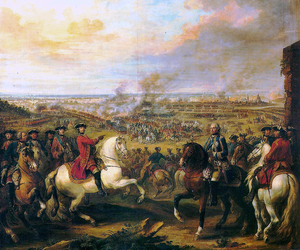With thanks to Ciarán Conlan who found this poem for us - it was posted by MaryAnne Maher on the Facebook page 18th Regiment of Foot Royal Irish Regiment(& South Irish Horse)Association™
“AN IRISH SOLDIER ‘NEATH’ SLIEVENAMON”
 |
| Slievenamon or Slievenaman Mountain |
Old hill! You’ve looked on many scenes of Ireland’s chequered story,
You’ve seen the “wild geese” fly to France and revelled in their glory;
You’ve heard the edict oft proclaimed – “To Hell or Connaught fly” –
And bent your head in sorrow as the victim’s pass’d you by.
But now, my grand old sentinel, another sun appears,
Dispelling past the clouds long cast in gloomy blood and tears.
No more the patriot outlaw seeks the shelter of your side,
To learn the soldier’s gallant trade, no more he needs to hide.
Amongst the rocky caverns, which dot your slopes, old hill,
And steal forth in the gloaming to join the moonlight drill,
For freedom’s sun is gleaming, and as “wild geese” never more
But as the gallant Irish soldiers we seek the Gaullic shore.
Unlike the days of Sarsfield, ‘tis no rotten Stuart cause,
Which calls is now to battle, and no tyrant alien laws,
Are there to make our King regret our loss to his own Crown,
Forgotten now is Fontenoy, but not our old renown,
Because on many bloody fields as in the days of yore,
The shamrock green in triumph’s seen for freedom evermore.
The savage Hun is weary, but we’re not conquered yet,
His deeds of blood at Ypres we’ll teach him to regret;
He trampled o’er our Irish dames, and there to us displayed,
What he had in store for Ireland if he won the game he played;
He little thought his mad assaults on priests and nuns also,
Would fiercely dart each Irish heart to deal him blow for blow.
The modern Attila now has grown sickly worn and grey,
His well-laid schemes of ruin and crime have sorely “ganged agley”
Our Munster boys and Connaught lands and Dublin Fusiliers,
And our Royal Irish heroes too of him have had no fears;
When we are marching home again lamenting comrades gone,
We’ll dry our tears in welcome cheers beneath old Slievenamon.
By A Drangan Boy
The Nationalist is a newspaper based in Clonmel in County Tipperary, Ireland. Established in 1890, it is a broadsheet newspaper published weekly, covering news, events, and sport in both Clonmel town and south Tipperary. It was formed to represent the views of the Irish nationalist community in County Tipperary, which led to the first editor been jailed under a Coercion Act on charges that he had intimidated a cattle dealer for taking a farm from which tenants had been evicted. It supported the Anglo-Irish Treaty, which led to the paper being shut down by Séumas Robinson during the Irish Civil War. The newspaper is currently owned by Iconic Newspapers, which acquired Johnston Press's titles in the Republic of Ireland in 2014.
Slievenamon or Slievenaman (Tr. "mountain of the women") is a mountain with a height of 721 metres (2,365 ft) in County Tipperary, Ireland. It rises from a plain that includes the towns of Fethard, Clonmel and Carrick-on-Suir. The mountain is steeped in folklore and is associated with Fionn mac Cumhaill. On its summit are the remains of ancient burial cairns, which were seen as portals to the Otherworld. Much of its lower slopes are wooded, and formerly most of the mountain was covered in woodland. A low hill attached to Slievenamon, Carrigmaclear, was the site of a battle during the Irish Rebellion of 1798.
Patrick Sarsfield, (born, Lucan, County Dublin, Ireland; died August 1693, Huy, Austrian Netherlands) - a Jacobite soldier who played a leading role in the Irish Roman Catholic resistance (1689–91) to England’s King William III. Sarsfield remains a favourite hero of the Irish national tradition.
 |
| Sarsfield |
The Battle of Fontenoy was a major engagement of the War of the Austrian Succession, fought on 11 May 1745 near Tournai in modern Belgium. A French army of 50,000 under Marshal Saxe defeated a Pragmatic Army of roughly the same size, led by the Duke of Cumberland.
The Term 'Hun' was a derogatory nickname used primarily by the British and Americans - officers rather than men - during the First World War to describe the German Army, e.g. "the Huns attacked at dawn". The origin of the term dated back to the Boxer Rebellion (1899-1900). When despatching his troops to China, Kaiser Wilhelm II instructed them in a speech he made to behave like the Huns of old and to wreak vengeance ("let the Germans strike fear into the hearts, so he'll be feared like the Hun"). According to W.A. Tucker in his memoir of his WW1 service “The Lousier War”, ordinary soldiers referred to the German troops as “Fritz”.
 |
| Attila the Hun |
Attila the Hun, was the ruler of the Huns from 434 until his death in March 453. He was also the leader of a tribal empire consisting of Huns, Ostrogoths, Alans and Bulgars, among others, in Central and Eastern Europe. He is also considered one of the most powerful rulers in world history.
Drangan is a village, census town and civil parish in County Tipperary, Ireland. It is in the historical barony of Middlethird.
https://www.facebook.com/groups/official18thregoffootroyalirishregassociation
“The Lousier War” by W.A.Tucker (The New English Library, London, 1974)
 |
| Battle of Fontenoy, 1745 by Pierre L'Enfant (1704 - 1987) |
